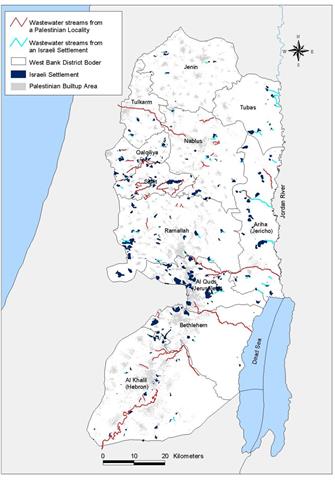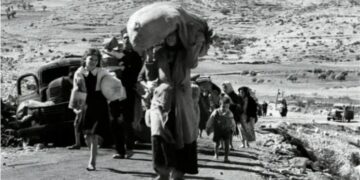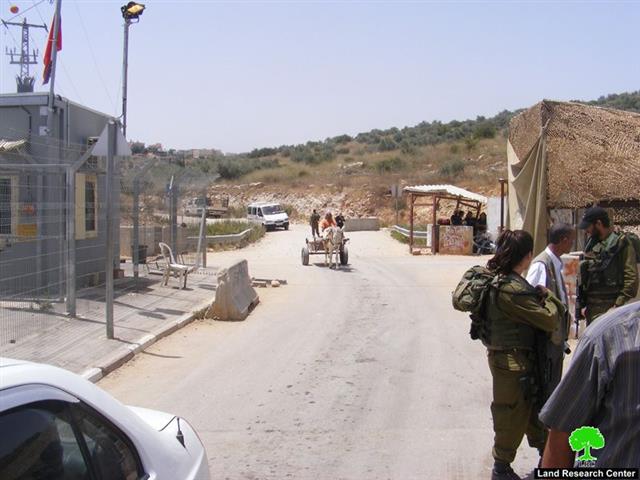The Israeli Ministry of Environmental Protection in cooperation with the Israel Nature and National Parks Protection Authority and the Israeli Civil Administration published a report last week on monitoring West Bank streams (streams pollution evaluation); the report points out that the wastewater flowing from Palestinian communities is the main source of contamination of water sources. At the same time, the report didn’t specify the harmful practices of Israeli settlers against the Palestinian environment, which significantly contribute to the degradation and depletion of natural resources and transform Palestinian areas into a garbage dump.
It is well known that the illegal Israeli settlements built on the lands of the occupied Palestinian Territory discharge their untreated wastewater into the Palestinian valleys and agricultural areas without any commitment to environmental standards and with indifference to Palestinian citizens living in the vicinity of the valleys and using the targeted agricultural areas for survival.
The quantity of wastewater generated annually by almost half a million Israeli settlers living in the West Bank, including Jerusalem, amounts to 54 MCM—a figure different from what the Israelis mentioned in their report. The Israeli report gives an estimation of about 17.5 MCM of waste water generated annually from Israeli settlers, but this figure doesn’t include the wastewater generated by almost 230,000 Israeli settlers living in the settlements inside Jerusalem as Israel doesn’t officially count them as settlements. The estimated annual amount of wastewater generated from the Palestinian communities in the West Bank is 52 MCM; thus, the amount of wastewater generated by Israeli settlers is more than the amount generated by 2.3 million Palestinian citizens. This can be attributed to the fact that Israeli settlers consume much more water for domestic purposes. An Israeli settler on average consumes five times as much water as a Palestinian citizen does. Map (1) shows the wastewater streams flowing from the Israeli settlements in the West Bank.
Map (1): the wastewater streams flowing from the Israeli settlements in the West Bank.
Since Israel occupied the West Bank (including East Jerusalem) and the Gaza Strip in 1967, it intentionally neglected the developmental projects designated for water and sanitation sector in the Occupied Palestinian Territory (OPT). At the same time, the Israeli Occupation authorities continued to collect taxes from Palestinians, but these taxes were mostly used in the interests of the occupation authorities and settlers. The facts indicate that the water and sanitation sector was continuously mismanaged by the Israelis, and even during the various stages of the peace process. The Israeli occupation authorities did not comply with the signed agreements related to the protection of environment and sustainable use of natural resources. Although the Palestinian Authority drew up plans and strategies related to the wastewater and its treatment, these plans were continuously rejected by the Israelis. For example, a wastewater treatment plant was planned in Al-Matwe Valley within the boundaries of Salfit city, and funding was provided by the KFW (Kreditanstalt für Wiederaufbau), a German government-owned development bank. However, obstacles and conditions set by the Israeli side prevented the success of the project. The plant was proposed to be built in area C, where Israeli approval and authorization for the project is required. Israel put forth the condition that the plant also to be used to treat wastewater generated from Ariel settlement (located in the Salfit governorate). Palestinians rejected the Israeli proposal, since it legitimizes the existence of the illegal Israeli settlement on their Land, and the project fell through.
A very similar situation occurred in Bethlehem governorate regarding the wastewater flowing in Wadi Al-Nar valley (Qidron Valley). A wastewater treatment plant was proposed by the Palestinians within the Bethlehem area, but the Israelis preconditioned their approval on the plant's treated wastewater generated from Israeli settlements located in Jerusalem including Ma’ale Adumim settlement bloc. In addition, the Israeli Occupation Authorities rejected the Palestinian request to treat the wastewater in Tulkarem governorate locally, and insisted on the transfer of the wastewater beyond the 1949 Armistice Line (Green Line) for treatment; this allowed the Israelis to take advantage of the treated wastewater and reuse it for agricultural purposes; at the same time, Israel charges the Palestinian National Authority NIS 1 (New Israeli shekel) for each cubic meter of wastewater. It should be noted that altogether, about 150 projects were suspended and frozen in the area; all of them aimed at improving the basic infrastructure services, particularly water and sanitation services for the Palestinian population. Israel cited security reasons for this. At the same time the Israeli settlements' water projects in the Palestinian areas don’t require any authorization, and Israel has kept good care of the water and sanitation systems in the West Bank settlements during the transition period.
Map (2): wastewater generated from Salfit city and Israeli Settlements in Wadi Al-Matwe valley
It is clear that the Israeli strategy in this regard is to control all Palestinian water resources; Israel presently exploits more than 80% of the fresh water resources in the OPT and is seeking to exploit the water generated by the wastewater treatment projects for its own agricultural purposes. The Palestinian side will pay the cost of treatment and will not benefit from the recycled water which is considered an important water resource.
Moreover, the Israeli Occupation Authorities try to draw funding for wastewater treatment plants from donor countries under the slogan of helping the Palestinians. Not least, they seek to use these plants to legitimize the existence of Israeli settlements in the Occupied Palestinian Territory.
Moreover, the Israeli report doesn't mention the role played by the Israeli factories in the destruction of the Palestinian environment. These factories dispose their industrial wastewater, which contains hazardous materials and toxic heavy metals and pigments, without any treatment near the Palestinian communities and adjacent valleys. This threatens the Palestinian population in those areas with significant health risks; additional adverse effects include groundwater pollution and destruction of nature and crops. A good example of this is the Barkan Israeli industrial zone and areas west of Ariel settlements, which was built on the lands of Salfit governorate in 1981, and is considered to be one of the largest Israeli industrial zones in the region. These trends are also visible in the Tulkarem areas, especially west of the town of Tulkarem, where there are many Israeli factories, including factories for agricultural pesticides, paints, dyes and plastics.
In the light of all this, the Applied Research Institute – Jerusalem (ARIJ) calls upon the international community and the donor countries to insist and to exert pressure on Israel to apply the agreements signed with the Palestinian side. These include giving the Palestinians full freedom to manage their natural resources and to apply environmentally sound management of solid wastes and wastewater. Wastewater treatment plants should be established in the suitable areas. Finally the right of the Palestinians to ensure compensation for the damages caused by Israel to the Palestinian environment must be acknowledged.
Prepared by
The Applied Research Institute – Jerusalem














